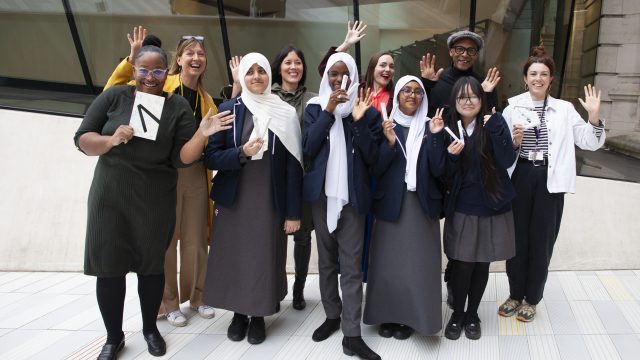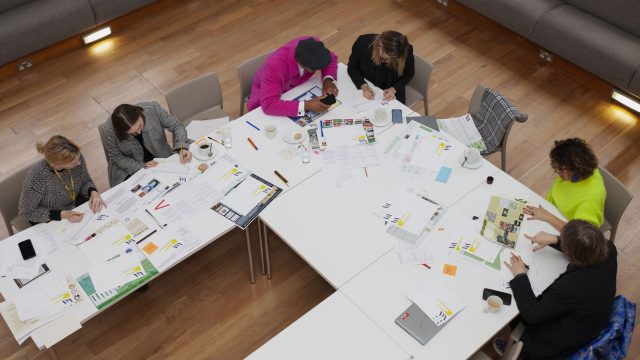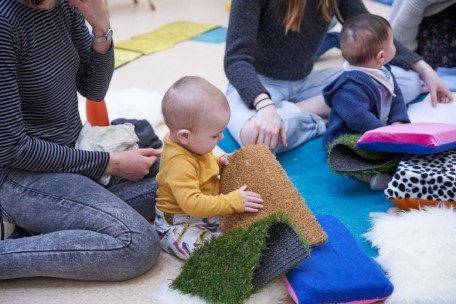
Isaac Jaggard, born 1600 (printer) and Edward Blount (printer), The First Folio, Museum Ref: L.1392-1882 © Victoria and Albert Museum, London
April 2014 marks the 450th anniversary of the birth of William Shakespeare, probably the most well-known playwright the world has produced. Such is his all-pervasive influence on our culture that even a cursory glance at the V&A’s online ‘Search the Collections’ reveals over 1,000 references to objects ranging from sculpture to ceramics, prints, drawings and jewellery.
As part of the Museum’s ‘Shakespeare Festival’ which will be held at the V&A throughout April, we will be working with a number of schools on a performance project called ‘Shakespeare in a Suitcase.’ Inspired by a higher-education event of the same name, devised and hosted at the V&A in 2012, the aims of the project are: to introduce schools to Shakespeare-related objects to inspire them to produce performances and re-interpretations of his plays and to give them the opportunity to perform at the Museum to the general public and other schools. The practical limitation is that anything the students need to produce their work must fit in a standard, family-sized suitcase.
A number of schools were approached in November last year to gauge their interest and expand on the project and six were chosen to take part. January and February saw the groups visit the V&A to have an introductory session which included a drama workshop, looking at ways of incorporating objects in performance and tours of the Theatre and Performance and other galleries.

Skull of Yorick used by Jonathan Pryce as Hamlet in Shakespeare’s Hamlet, Royal Court Theatre 1980, Museum Ref: S.151-2007 © Victoria and Albert Museum, London
The workshop encouraged the group to relate to an object within the V&A that might help to symbolise a play – a dagger for Macbeth, for example or a handkerchief for Othello…
In the first exercise, the group were invited to form a standing circle and were introduced to the object (in this example, a glass, mirrored jewellery box) by being told that ‘this object is owned, or in the possession of, a Shakespearean character you know very well…’ The group were free to choose any character they knew. In the event that they didn’t know a Shakespeare character, any fictional character would actually work. The purpose was to ‘hook’ the group to the object and begin the process of dramatic invention.
The object was placed in the middle of the circle where it remained for the length of the session.
The group were asked to perform a series of imaginative tasks together such as saying the name of their character out loud to the object. To create varying mood and atmosphere, the names were whispered or shouted or echoed; individuals were given a number between one and five. All the ones spoke together first, then twos etc…They were asked to give their spoken word an intention in relation to the audience: Did they want to scare the audience, intrigue them or something different ? An underlying theme of the workshop structure was to play physically and vocally with ‘contrast’ – fast / slow, up / down, loud / quiet…

Siegmund Hildesheimer & Co, ‘King Richard III Act III Scene 1″, 1890s, Museum Ref: S.63-2008 © Victoria and Albert Museum, London
All were invited to think of three adjectives that their character would use about the object and to say these aloud, with intentions too. Movement was added by asking small groups to imagine how the object would move if it could. The group were not asked to ‘be’ the box but to find a way of suggesting the essence of its possible movement e.g. a gliding, smooth motion that referenced the shiny, mirror-like quality of the box.
Finally, each student was asked to take up a physical still-image that represented the summing-up of their thoughts, as the character, about the object – some ended up almost on top of the box, holding it tight; others put themselves at the furthest point away from the object, against the walls of the playing space. The result was an intriguing final image with the group frozen at varying levels and distances between themselves and the jewellery box.
The above could form the basis of an effective opening to their piece. There is now the scope to explore characters’ stories in more depth and to explain to an audience what significance the object has for them.
In the time available, the group could only begin this process. The objects in the Museum have a wealth of background material in terms of label information and object stories that can also be used to add depth to the students’ work – this will form the focus of the next stage where they will choose a play and begin preparation for their performances.
At the end of this section, students were asked to fill out, on paper, responses to four simple statements:
‘Shakespeare. When I see this name I think…
Shakespeare’s plays are…
Museums. When I see this word I think…
I think performing in a museum will be…’
These will be revisited at the end of the project to see if each of the schools’ appreciation has changed, hopefully in a positive way.
To see a list of workshops, talks and performances running during the Shakespeare Festival take a look at http://www.vam.ac.uk/page/s/shakespeare/
VIDEO FILTER – INVALID CODEC IN: [video:http://www.vam.ac.uk/channel/happenings/learning/shakespeare_in_a_suitcase/ width:480 height:300]


